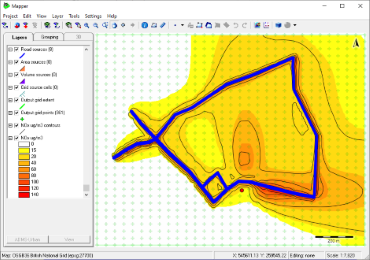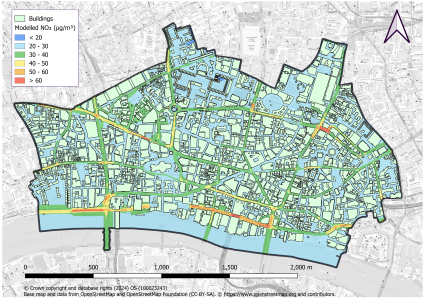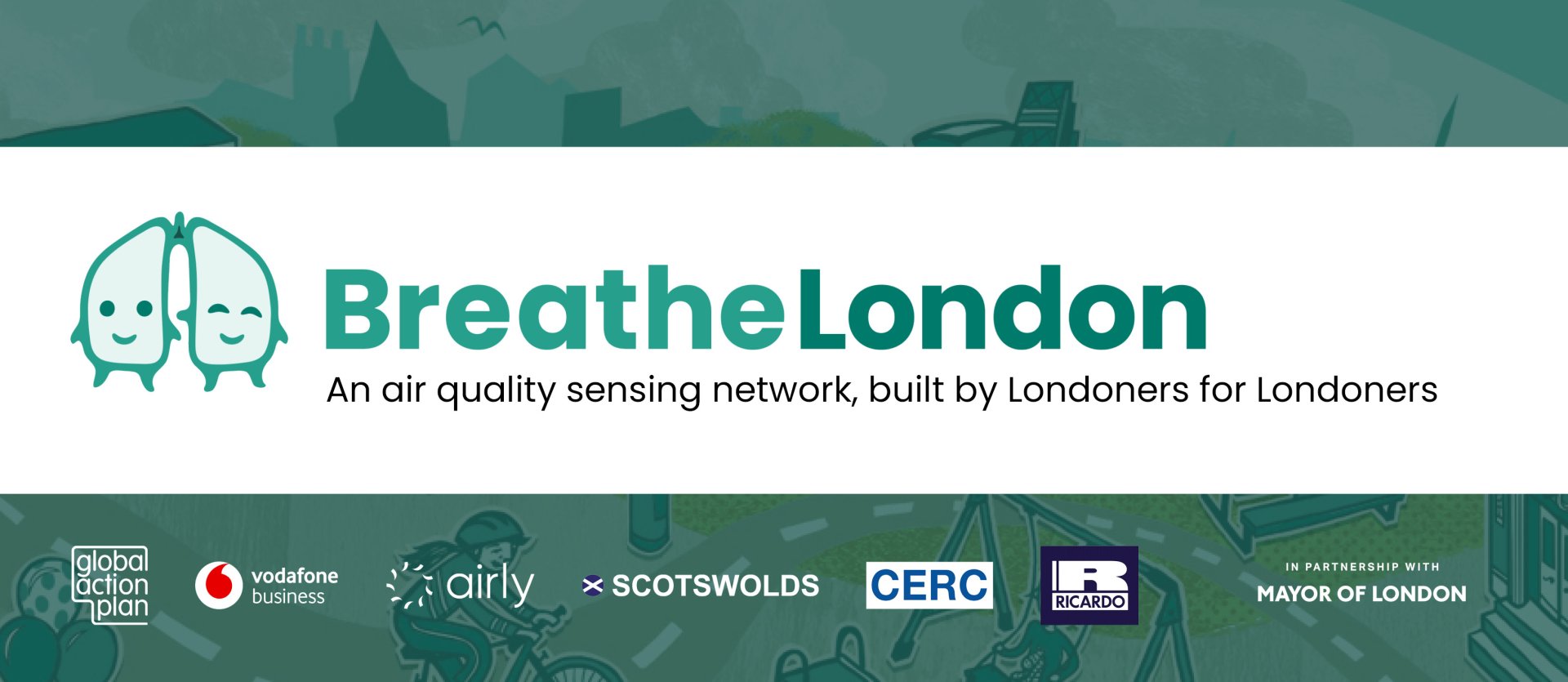CERC news
< Previous12345678910111213141516171819Next >

3 Sep 2025Major new release of ADMS-Urban, ADMS-Roads & ADMS-Airport 5.1
Version 5.1 is a major update of ADMS-Urban, ADMS-Roads and ADMS-Airport with many powerful new features to aid modelling, data processing and visualisation.
ADMS-Urban, ADMS-Roads and ADMS-Airport are comprehensive tools for investigating air pollution, taking account of complex urban morphology including street canyons and road tunnels.
ADMS-Roads is designed primarily for networks of roads that may be in combination with industrial sites, for instance small towns or rural road networks.
ADMS-Urban can model large urban areas providing output from street-scale to urban-scale.
ADMS-Airport has all the features of ADMS-Urban, and can also incorporate all relevant emission sources at airports including using algorithms designed specifically to model dispersion from aircraft engines.
New features include:
- Urban Canopy and Advanced Street Canyon Mapper tools for faster calculation of urban morphology parameters without requiring separate GIS software
- The latest emission factors from Defra's Emission Factor Toolkit, EFT 13.1
- A verification mode for checking model inputs and generating information about the model run
- A shape file (.shp) merging tool, including field adding, deleting and renaming
- Compatibility with ADMS 6 .apl files
- Plus many enhanced usability functions throughout the Mapper and interface.
All the new features are described in detail in the What's New? guides.
Users with support will get this version within the next few working days.
For further information on this release or any CERC products please contact us.

29 Aug 2025London Atmospheric Emissions Inventory 2022 released
The latest version of the London Atmospheric Inventory (LAEI 2022) has been published on the London Datastore. The LAEI 2022 includes traffic flow and emissions data for nearly 80,000 roads in the Greater London area as well as emissions data for all other sources of air pollution defined on a 1-km grid. Data are provided for a 2022 base year with projections to 2025 and 2030.
The latest release shows a 23% reduction in NOx emissions between 2019 and 2022, largely driven by reductions in road transport emissions, with emissions forecast to reduce by a further 29% by 2030. PM2.5 emissions have reduced by 6% over the same period, while PM10 emissions in 2022 remain broadly similar to 2019 levels.
The comprehensive data available in the LAEI allows CERC to carry out detailed air quality modelling for a wide range of current and future cases including air quality forecasting and the assessment of the impacts of Low Traffic Neighbourhoods.
The Consultancy team's first project using the 2022 LAEI will be to assess progress towards the aim set out in the City of London Air Quality Strategy 2025-2030 for over 90% of the Square Mile to meet an annual mean of 30 µg/m3 for nitrogen dioxide by 2030.
We will use ADMS-Urban to model the impact of all emissions in London. The impact of the Central London's complex urban topography on road traffic emissions will be taken into account using the ADMS Advanced Canyon and Tunnels options. Non-road emissions will be modelled using grid sources. The resulting 1-metre resolution concentration maps will then be calibrated using local monitoring data.
CERC has carried out similar assessments for the City of London annually since 2018. One aim of the previous air quality strategy was for 90% of the Square Mile to meet the national air quality standard for annual mean NO2 of 40 µg/m3 by 2025. Over the past seven years, changes have included the introduction of the Ultra Low Emissions Zone, new traffic restrictions at Bank Junction, and the introduction of the Beech Street Zero Emissions Street, as well as changes brought about by the Covid pandemic. The effects of all of these changes on emissions were incorporated into CERC's modelling. The modelling showed that the percentage of the Square Mile meeting the standard increased from 30% in 2018 to 93% in 2020, since when it has remained approximately constant.

24 Jun 2025CERC working with Vodafone on Mayor of London’s Breathe London sensor network
CERC is delighted to be part of the new consortium running the Mayor of London's Breathe London network. The consortium will coordinate all 136 existing air quality sensor sites across the capital, introducing advanced methodologies for sensor calibration and data quality assurance, and engaging key community groups and organisations such as schools, NHS Trusts and Local Authorities to make accurate air quality data available to everyone in London, and mobilise communities in the fight against toxic air.
CERC's role is to provide a robust and reliable operational calibration and quality control system, and secure online access to the current and historical NO2 and PM2.5 measurements through the Breathe London API. The network calibration system was developed using an innovative scale-separation technique pioneered by consortium members Professor Rod Jones and Dr Olalekan Popoola from the University of Cambridge. Amy Stidworthy from CERC's Forecasting and Data Services team explains the network calibration method and gives examples of comparisons with measurements from reference-standard instruments in this video.
The Breathe London Consortium is led by Vodafone, who also provide sensor connectivity and hosting infrastructure, and brings together leading experts in all aspects of air quality. Airly provides the sensors, Scotswolds provides expert oversight of sensor installation and data quality, Global Action Plan leads community engagement including the website, and Ricardo will conduct an independent annual review of sensor data quality.
Announcing the new phase of Breathe London, the Mayor of London, Sadiq Khan said: I am delighted that Vodafone will deliver the next stage of my pioneering Breathe London programme by leading a consortium of partners and utilising their technical expertise and advanced connectivity. Reducing London's air pollution is one of my top priorities and this advanced monitoring network will provide invaluable data to help organisations across the capital take action on air quality and protect public health.
You can read the full press release online.

14 Apr 2025Booking is now open for the ADMS User Group Meetings, 26-27 November 2025, Bristol
You can now book your tickets for the 2025 ADMS User Group Meetings, which will be held at the M Shed on 26th and 27th November.
The annual ADMS User Group Meetings are a great opportunity to hear the latest ADMS model news and advice from CERC consultants and model developers, to hear talks by model users about their own applications of the software, and to network with other model users.
Tickets are available to order through Eventbrite until 23:30 on Monday 10th November. Organisations with a valid software support contract are entitled to one or more tickets free of charge depending on the type of licence held. The draft programme will be published soon.

31 Mar 2025Calculating health impacts of air pollution in Oxfordshire
Oxfordshire County Council are working with CERC and the University of Birmingham to calculate the air quality and health impacts of potential policy scenarios including the county and national Net Zero ambitions.
CERC are using ADMS-Urban to calculate detailed pollution maps across all of Oxfordshire in order to generate input data into the University of Birmingham's Air Quality Lifecourse Assessment Tool (AQ-LAT) which estimates ward-level impacts of PM2.5 and NO2 on health outcomes, mortality and associated healthcare costs.
The differences in the dispersion of pollutants in the City of Oxford compared to the rest of the county, which is largely rural, have been taken into account by using the Advanced Street Canyon and Urban Canopy tools in ADMS-Urban as well as varying area-wide dispersion parameters.
Base-year concentration maps have been generated and the concentrations averaged by Lower layer Super Output Area (LSOA) for use in AQ-LAT (see figure).
CERC are currently finalising the future scenario testing with Oxfordshire County Council. A baseline for 2035 using projected road and non-road emissions has been produced including proposed traffic filters, electrification of the bus fleet and Oxford City's Zero Emission Zone. The impact of additional policies, including the reduction of traffic, further electrification of the vehicle fleet and reductions in domestic wood burning, will be evaluated by adjusting the emissions, modelling the impact on ambient concentrations and calculating the resulting impact on health.
You can also follow CERC news on Facebook, X, LinkedIn and by RSS.
< Previous12345678910111213141516171819Next >

